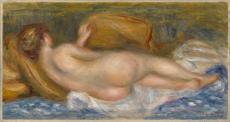


The female nude was a constant theme in Renoir’s oeuvre, each decade of his career counting at least one significant example of this genre. Let us recall his La Baigneuse au Griffon from the Salon of 1870 (Sao Paulo, Museu de Arte), which reinterpreted both classic statuary and Gustave Courbet (1819-1877); or Étude: Torse, Effet de Soleil (Paris, Musée d’Orsay), which was vilified at the Impressionist exhibition of 1876 as ‘a mass of flesh in the process of decomposition with green and violet spots which denote the state of complete putrefaction of a corpse!’, but which became the paragon of the Impressionist nude. These were followed in 1887 by Grandes Baigneuses: Essai de Peinture Décorative (Philadelphia Museum of Art), the figures of which, with their firm and definite lines and their acid colours, mark the pinnacle of his Ingresque period, as opposed to the coloured vibrations of Impressionism. When Renoir next returned to a more supple style and a warmer palette, he also did so in regard to an entire series of nudes, which, after the monumental, isolated figures of his seated, opulent bathers, ended with his final work, Baigneuses of 1918-1919 (Paris, Musée d’Orsay), rendered in very vivid flesh tones that contrast with the vegetation, out of which the women appear to be blossoming.
Femme Nue Couchée Vue de Dos, not precisely dated by the artist, which was generally the case, has often been placed around 1895-1897, and it is true that the art dealer Ambroise Vollard (1866-1939), from whom this canvas came without a doubt, sold around that time several of Renoir’s nudes seen from the back, a subject which apparently was not very common. As this work is of a relatively modest format, which sought to preserve the elan, the spontaneity and the freshness of the initial sketch, and consequently its style is less fixed, the chronological period to which we may ascribe it becomes more uncertain. Nonetheless, this painting already denotes the artist’s evolution towards a cursive and rapid method of execution, fitting with works painted after 1900. The presence, on the reverse side of the painting, which is on its original canvas, of a stamp of the canvas supplier Blanchet, 38, Rue Bonaparte, which had been the address of the shop since 15 January 1905, forces us to revise the traditional date and to propose a later date, around 1905-1907. This is also the date of a large, monumental nude seen from the front belonging to the Musée d’Orsay, also posed for by a model with reddish blonde hair.
The model in the A. G. Leventis Collection painting, modestly positioned with her back to the viewer, was not subjected to a constraining pose, but instead appears to have surrendered to rest, assuming a very natural position, her left hand holding on to a cushion about to topple over her. The space in which the young woman is depicted remains abstract, atemporal and closed. Without wishing to characterise her as a Venus or a Diana, at a time when it was still appropriate to invoke mythology in order to paint a nude (and indeed the painter willingly obliged in the case of other paintings), Renoir chose simply to depict a model. Nor did he wish to suggest the contemporary context of a naturalist spirit, as he sometimes did at the beginning of his career. The most attractive trait in this small painting is the agility of the paint brush, which, with only a few strokes, has set the position of the figure, has shaped the flesh with the help of grey-blue tones, and has suggested the background by the smeared-on paint which barely covers the canvas. A light white impasto gives substance to the fabrics upon which the young woman reposes. This extremely simple layout does not seem to have been reprised in a more elaborate composition, but belongs to a series of reclining nudes which Renoir began at the turn of the century, and which includes certain large-format works, such as the one in the Musée d’Orsay cited above.
Yet, beyond this apparent naivety, Renoir was aware that he was competing with the once famous archetypes proposed by Titian (c. ?1484-1490 – 1576), Rubens (1577-1640), Boucher (1703-1770), Fragonard (1732-1806) and Ingres (1780-1867), or even Corot (1796-1875). He did not plagiarise them, and one would search in vain for a precise source for this nude seen from the back. Vollard, relating a conversation he had with the painter on the subject of a nude by Titian in Madrid’s Museo del Prado, showed very clearly Renoir’s fascination with these Old Masters and, in particular, with regard to flesh: ‘The limpidity of this meat, one feels like caressing it! How strongly one can feel, standing in front of this painting, the happiness Titian felt while painting the softness of this flesh… When I see, in a painter’s work, the passion he felt while painting, I take pleasure in his pleasure.
He found work as a porcelain painter at age 13. In 1862, he began studying in the studio of Charles Gleyre, where he met Claude Monet, Frédéric Bazille and Alfred Sisley, with all of whom he went on to lead the Impressionist movement. He is known for his portraits, especially depictions of children, his sensual nudes, floral still lifes and his depictions of modern life, in which each figure preserves their individuality. He experimented with new techniques and styles throughout his career and was the first Impressionist to shift away from the group’s main direction. Influences on him were wide-ranging, from Raphael, Velázquez and Rubens to Rococo painters, Ingres and his own contemporaries. Despite the crippling rheumatism of his later years, he painted until the last hours of his life.